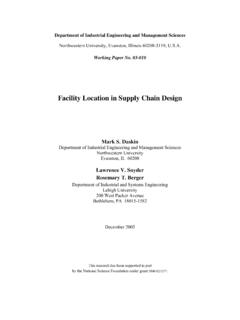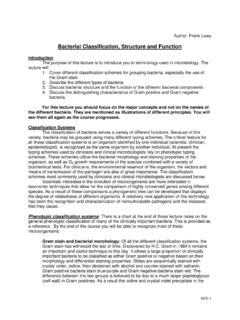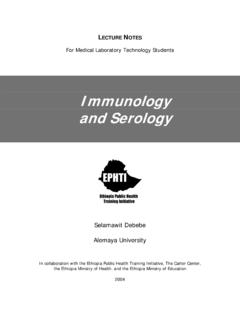Transcription of Introduction to Bioinformatics - Lehigh University
1 Introduction to Bioinformatics LoprestiBioS 95 November 2008 Slide 1 Dan LoprestiAssociate ProfessorOffice PL BioinformaticsIntroduction to Bioinformatics LoprestiBioS 95 November 2008 Slide 2 Motivation Biology easily has 500 years of exciting problems to work on. Donald Knuth (Stanford Professor & famous computer scientist)By developing techniques for analyzing sequence data and related structures, we can attempt to understand molecular basis of to Bioinformatics LoprestiBioS 95 November 2008 Slide 3 Before We Get GoingRecall your recent lectures by Professors Marzillier and Ware who presented biological background: Today I'll focus on the related computational questions. Professor Marzillier's lecture on Nov Ware's lecture on Nov to Bioinformatics LoprestiBioS 95 November 2008 Slide 4 What is Bioinformatics ?Application of techniques from computer science to problems from is it interesting?
2 Important problems. Massive quantities of data. Desperate need for efficient solutions. Success is ScienceBiologyIntroduction to Bioinformatics LoprestiBioS 95 November 2008 Slide 5 Data ExplosionTo first approximation, DNA is a language over a four character alphabet, {A, C, G, T}. (1) Adenine,(2) Cytosine,(3) Guanine,(4) genetic identity isencoded in long molecules made up of four basic units,the nucleic acids: Introduction to Bioinformatics LoprestiBioS 95 November 2008 Slide 6 GenomesComplete set of chromosomes that determines an organism is known as its musculusConclusion: size does not matter!(But you already knew this. ) Introduction to Bioinformatics LoprestiBioS 95 November 2008 Slide 7 Comparative did we decipher these relationships?Recall this amazing diagram from Professor Ware's lecture : Introduction to Bioinformatics LoprestiBioS 95 November 2008 Slide 8 Algorithms are Central Conduct experimental evaluations (perhaps iterate above steps).
3 An algorithm is a precisely-specified series of steps to solve a particular problem of interest. Develop model(s) for task at hand. Study inherent computational complexity: Can task be phrased as an optimization problem? If so, can it be solved efficiently? Speed, memory, etc. If we can't find a good algorithm, can we prove task is hard ? If known to be hard, is there approximation algorithm (one that works at least some of the time or comes close to optimal)? Introduction to Bioinformatics LoprestiBioS 95 November 2008 Slide 9 Sequence Nature of BiologyMacromolecules are chains of simpler DNA and RNA, they are the case of proteins, these basic building blocks are amino to Bioinformatics LoprestiBioS 95 November 2008 Slide 10 NCBI Center for Biotechnology Information (NCBI), which is branch of National Library of Medicine (NLM), which is branch of National Institutes of Health (NIH), maintains GenBank, a worldwide repository of genetic sequence data (all publicly available DNA sequences).
4 Massive quantities of sequence data need for good computational to Bioinformatics LoprestiBioS 95 November 2008 Slide 11 Reading ~wellsctr/MMIA/ general, DNA molecules with similar lengths will migrate same DNA fragments that end at each base: A, C, G, T. Then run gel and read off sequence: ATCGTG ..Gel electrophoresis is process of separating a mixture of molecules in a gel media by application of an electric is known as Professor Marzillier's lecture : Introduction to Bioinformatics LoprestiBioS 95 November 2008 Slide 12 Reading DNAATCGTGTCGATAATCGTGTCGAAAO riginal sequence: ATCGTGTCGATAGCGCTGATCGTGTCGATAGATCGTGTCG ATCGTGATCGATCGTGTCGATAGCGTATCGTGTCGATATC GTGTCGATAGCGCTATCGTGTATCGTATATCGTGTCGATA GCGCATCGTGTCGATAGCATCGTGTCATCCI ntroduction to Bioinformatics LoprestiBioS 95 November 2008 Slide 13 Sequencing a GenomeMost genomes are enormous ( , 1010 base pairs in case of human).
5 Current sequencing technology, on the other hand, only allows biologists to determine ~103 base pairs at a leads to some very interesting problems in Bioinformatics ..Genetic linkage map(107 108 base pairs)Physical map(105 106 base pairs)Sequencing(103 104 base pairs) to Bioinformatics LoprestiBioS 95 November 2008 Slide 14 Sequencing a GenomeGenomes can also be determined using a technique known as shotgun scientists have played an important role in developing algorithms for assembling such 's kind of like putting together a jigsaw puzzle with millions of pieces (a lot of which are blue sky ). Introduction to Bioinformatics LoprestiBioS 95 November 2008 Slide 15 Sequence Assemblyfragmentsfragmentassemblyorigina ltargetcontigcontiggapIntroduction to Bioinformatics LoprestiBioS 95 November 2008 Slide 16 Sequence AssemblyA simple model of DNA assembly is the Shortest Supersequence Problem: given a set of sequences, find the shortest sequence S such that each of original sequences appears as subsequence of for overlap between prefix of one sequence and suffix of another: Introduction to Bioinformatics LoprestiBioS 95 November 2008 Slide 17 Sequence AssemblySketch of algorithm: Create an overlap graph in which every node represents a fragment and edges indicate overlap.
6 Determine which overlaps will be used in the final assembly: find an optimal spanning forest in overlap = AGTATTGGCAATC Z = AATCGATGU = ATGCAAACCTX = CCTTTTGGY = TTGGCAATCAS = AATCAGG wzxusy543349 Introduction to Bioinformatics LoprestiBioS 95 November 2008 Slide 18Z U XW Y SSequence Assembly Look for paths of maximum weight: use greedy algorithm to select edge with highest weight at every step. Selected edge must connect nodes with in- and out-degrees <= 1. May end up with set of paths: each corresponds to a TTGGCAATCA AATCAGGAATCGATG ATGCAAACCT CCTTTTGGAGTATTGGCAATCAGGAATCGATGCAAACCTT TTGG wzxusy543349 Introduction to Bioinformatics LoprestiBioS 95 November 2008 Slide 19 Sequence Comparison Given new DNA or protein sequence, biologist will want to search databases of known sequences to look for anything similar. Sequence similarity can provide clues about function and evolutionary relationships.
7 Databases such as GenBank are far too large to search search them efficiently, we need an 's the problem? Google for biologists ..Shouldn't expect exact matches (so it's not really like google): Genomes aren't static: mutations, insertions, deletions. Human (and machine) error in reading sequencing to Bioinformatics LoprestiBioS 95 November 2008 Slide 20 Genomes Aren't StaticSequence comparison must account for such to Bioinformatics LoprestiBioS 95 November 2008 Slide 21 Genomes Aren't StaticDifferent kinds of mutations can arise during DNA replication: to Bioinformatics LoprestiBioS 95 November 2008 Slide 22 The Human FactorIn addition, errors can arise during the sequencing process: ..the error rate is generally less than 1% over the first 650bases and then rises significantly over the remaining sequence. hard-to-read gel (arrow marks location where bands of similar intensity appear in two different lanes): also make mistakes, of course!
8 Introduction to Bioinformatics LoprestiBioS 95 November 2008 Slide 23 Sequence ComparisonAGTCTATAATTCTGTAD ifference = 2 AGTCTATAGTCTATAD ifference = 8 Why not just line up sequences and count matches?Doesn't work well in case of deletions or insertions:One missing symbol at start of sequence leads to large difference! Introduction to Bioinformatics LoprestiBioS 95 November 2008 Slide 24 Sequence Comparison Model allows three basic operations: delete a single symbol, insert a single symbol, substitute one symbol for another. Goal: given two sequences, find the shortest series ofoperations needed to transform one into the TSubstitute G for AInstead, we'll use a technique known as dynamic to Bioinformatics LoprestiBioS 95 November 2008 Slide 25 Sequence Comparison Approach is to build up longer solutions from previously computed shorter solutions. Say we want to compute solution at index i in first sequence and index j in second sequence:Sequence 1iSequence that we already know the best way to compare:Sequence 1iSequence 1 Sequence 1 Sequence can we determine optimal series of operations?
9 Introduction to Bioinformatics LoprestiBioS 95 November 2008 Slide 26 Sequence ComparisonSo, best way to do this comparison:Sequence 1iSequence best choice from following three cases:Sequence 1iSequence 2vs.+ inserting jSequence 1 Sequence 2jvs.+ deleting iSequence 1 Sequence 2vs.+ substituting forijIntroduction to Bioinformatics LoprestiBioS 95 November 2008 Slide 27 Sequence Comparisons e q u e n c e ss e q u e n c e t 0cost of inserting tcost of deleting sd [i-1, j] + 1d [i, j-1] + 1d [i, j] = minNormally, this computation builds a table of distance values:0 if s[i] = t[j]1 if s[i] t[j]d [i-1, j-1] + Introduction to Bioinformatics LoprestiBioS 95 November 2008 Slide 28 Sequence ComparisonBy keeping track of optimal decision, we can determine operations: Introduction to Bioinformatics LoprestiBioS 95 November 2008 Slide 29 Genome Rearrangements 99% of mouse genes have homologues in human genome.
10 96% of mouse genes are in same relative location to one another. Mouse genome can be broken up into 300 synteny blocks which, when rearranged, yield human genome. Provides a way to think about evolutionary what we saw earlier: Introduction to Bioinformatics LoprestiBioS 95 November 2008 Slide 30 Reversal Distance12345-352-41-3-2-1451-3-2-5-4 Human Chromosome XMouse Chromosome XCut and reverseCut and reverseCut and reverseReversal distance is the minimum number of such steps to Bioinformatics LoprestiBioS 95 November 2008 Slide 31 Interesting SidenoteEarly work on a related problem, sorting by prefix reversals, was performed in 1970's by Christos Papadimitriou, a famous computer scientist now at UC Berkeley, and one William H. Gates ..Yes, that Bill Gates .. Introduction to Bioinformatics LoprestiBioS 95 November 2008 Slide 32 History of Chromosome XRat Consortium, Nature, 2004 Hypothesized reversalsIntroduction to Bioinformatics LoprestiBioS 95 November 2008 Slide 33 Waardenburg s SyndromeMouse provides insight into human genetic disorder: Waardenburg s syndrome is characterized by pigmentary dysphasia.















